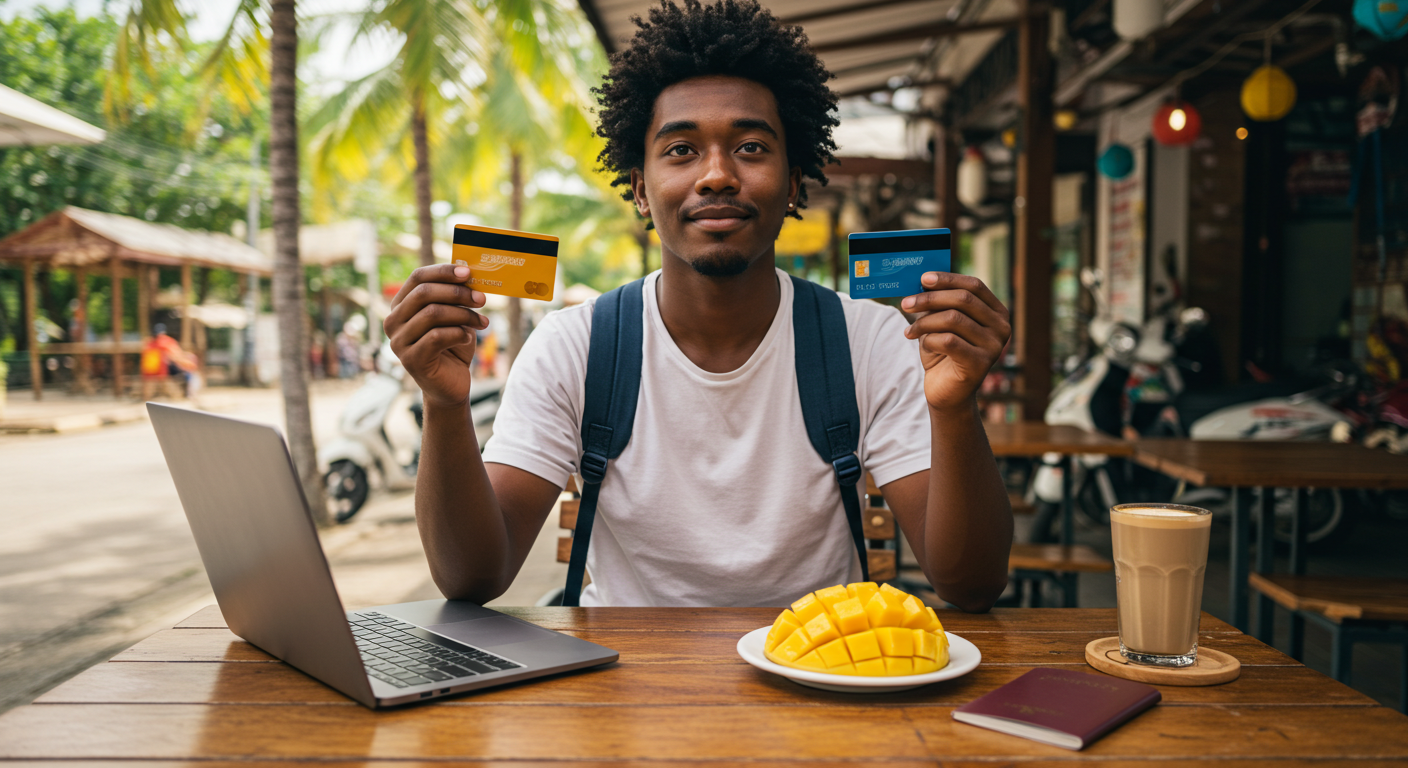
Why You Should Always Have More Than One Bank Account: A Financial Safety Net That Could Save Your Trip (And Your Sanity)
TL;DR
Having just one bank account is financial Russian roulette, especially for travelers. A single error, hold, or freeze can leave you stranded without access to your money. By setting up multiple accounts (primary checking, backup checking, and high-yield savings), you create a financial safety net that protects you from banking glitches, fraud, and emergencies. This simple step can mean the difference between a minor inconvenience and a full-blown crisis.
The Real-World Wake-Up Call Every Traveler Needs to Hear
Picture this: You've just spent five incredible months exploring Southeast Asia, creating memories that will last a lifetime. You're ready to head home, flight booked, payment processed – everything's perfect. Then three days later, you wake up to a financial nightmare that could derail your entire journey home.
This isn't a hypothetical scenario. It's exactly what happened to me, and it's a stark reminder of why having multiple bank accounts isn't just smart financial planning – it's essential financial survival.
The Banking Catastrophe That Almost Ruined My Homecoming
After months of adventure across Southeast Asia, I was ready to return to the US. I found my flight, went through checkout, saw "Payment Complete" – the works. I celebrated, already mentally preparing for the comfort of my own bed.
Three days later, reality hit like a freight train. My checking account was in the negative. The airline had processed another hold on my account for the full ticket price, essentially charging me twice for the same flight. My debit card was instantly useless, my funds frozen, and I was stuck in a foreign country with limited access to my money.
But here's where preparation saved the day.
Why Multiple Bank Accounts Are Your Financial Lifeline
Protection Against Banking Errors and Merchant Mistakes
Banking errors happen more frequently than most people realize. Whether it's:
Duplicate charges from merchants
Incorrect holds placed by airlines, hotels, or rental companies
Technical glitches during payment processing
Fraudulent activity that triggers account freezes
Having multiple accounts means one frozen or problematic account won't leave you completely stranded.
Instant Access to Emergency Funds
When your primary checking account goes negative or gets frozen, you need immediate alternatives. Multiple bank accounts provide:
Instant liquidity – Transfer funds between accounts within hours
Continued card access – Use debit cards from unaffected accounts
ATM flexibility – Access cash through different banking networks
Payment redundancy – Complete transactions even when one account fails
Geographic and Technical Diversification
Different banks have different:
International partnerships and ATM networks
Technical systems and potential downtime windows
Customer service availability across time zones
Fee structures for international transactions
The Strategic Setup: How to Structure Multiple Accounts
Primary Checking Account
Keep your daily spending money here – typically 1-2 months of expenses. This account handles:
Regular bills and subscriptions
Daily purchases and transactions
ATM withdrawals for cash needs
Secondary Checking Account (Different Bank)
Your financial backup plan should contain:
2-4 weeks of emergency expenses
Access through a completely different banking system
Different debit card network (Visa vs. Mastercard)
High-Yield Savings Account
Store the majority of your funds in a high-yield savings account:
Better interest rates than checking accounts
Protection against impulsive spending
Easy transfer capabilities to checking accounts
Travel-Specific Considerations
For frequent travelers, consider:
Accounts with no foreign transaction fees
Banks with strong international ATM partnerships
Online banks with 24/7 customer service
Credit cards as additional backup payment methods
The Hour-by-Hour Recovery Plan That Saved My Trip
When I discovered my account was negative, here's exactly how multiple accounts saved me:
Hour 1: Logged into my second bank account, initiated transfer from savings Hour 3: Funds appeared in secondary checking account
Hour 4: Successfully purchased mangoes for breakfast (and restored my sanity) Later: Dealt with the airline issue while maintaining full financial flexibility
The problematic account remained negative while sorting out the airline's mistake, but I never lost access to my money or ability to make purchases.
Common Banking Mistakes That Leave Travelers Vulnerable
Keeping Everything in One Institution
Many people use the same bank for checking, savings, and credit cards. When that bank experiences issues:
All your financial tools become unavailable simultaneously
Customer service bottlenecks affect all your accounts
Technical problems cascade across your entire financial setup
Insufficient Emergency Fund Distribution
Keeping emergency funds only in savings accounts can create delays when you need immediate access to cash for:
Transportation during account issues
Food and accommodation while resolving problems
Communication costs (phone, internet) to contact banks
Lack of International Banking Preparation
Traveling without considering how your banks operate internationally leads to:
Surprise foreign transaction fees
Cards declined in certain countries
Limited customer service during your destination's time zone
Setting Up Your Financial Safety Net: Step-by-Step Guide
Step 1: Choose Your Banks Strategically
Select banks based on:
Different core banking systems – Avoid banks that share infrastructure
Complementary ATM networks – Ensure wide geographic coverage
Varied fee structures – Some better for international use, others for domestic
Different customer service strengths – 24/7 availability, multilingual support
Step 2: Distribute Your Funds Wisely
40-50% in high-yield savings (primary bank)
30-40% in primary checking account
10-20% in secondary checking account (different bank)
Step 3: Test Your System Before You Need It
Practice transferring funds between accounts
Verify international functionality of all cards
Confirm customer service contact methods
Set up account alerts and monitoring
Step 4: Maintain Regular Account Activity
Keep all accounts active by:
Making small purchases monthly on each debit card
Setting up small automatic transfers
Monitoring for minimum balance requirements
Avoiding dormancy fees
The Cost of Not Being Prepared
Consider what happens when financial access fails:
Stranded abroad with limited cash and no card access
Missed flights or accommodations due to payment failures
Emergency expenses for extended stays while resolving issues
Stress and anxiety during what should be enjoyable travel
Dependency on others for financial assistance
The small effort of maintaining multiple accounts pales in comparison to these potential consequences.
Beyond Banking: Complete Financial Redundancy
Multiple Payment Methods
Various debit cards from different banks
Credit cards from different issuers
Digital payment apps (when accepted internationally)
Small cash reserves in multiple currencies
Documentation Backup
Physical and digital copies of account information
Emergency contact numbers for all financial institutions
Account numbers and routing information stored securely
Backup identification for account verification
Communication Preparedness
International phone plans or local SIM cards
Messaging apps that work without cellular service
Email access from any device
Written contact information (not just stored in phones)
The Bottom Line: Financial Resilience Isn't Optional
My Southeast Asia experience taught me that financial preparedness isn't paranoia – it's practical wisdom. The difference between a minor inconvenience and a major crisis often comes down to having multiple financial options.
Banking errors, merchant mistakes, and technical glitches are inevitable parts of modern financial life. The question isn't whether these issues will affect you, but whether you'll be prepared when they do.
Don't wait until you're standing in a foreign country with a negative account balance and no backup plan. Set up multiple accounts now, distribute your funds strategically, and ensure you're never left without financial options.
Because sometimes the difference between disaster and just another travel story is having the ability to buy mangoes for breakfast while you sort everything out.
Take Action Today
Open a second checking account at a different bank than your primary institution
Research high-yield savings options to maximize your emergency fund growth
Test international functionality of all your cards before traveling
Set up account monitoring and alerts to catch issues early
Create a written emergency contact list for all your financial institutions
Your future self – whether traveling or dealing with everyday banking mishaps – will thank you for the preparation.
How Financial Preparedness Fits Into Your Holistic Lifestyle
This banking experience perfectly illustrates a core principle I teach: true wellness extends far beyond diet and exercise. Holistic living means creating systems that support your wellbeing in every area of life – physical, mental, emotional, and yes, financial.
When your financial foundation is solid and prepared for unexpected challenges, you eliminate a major source of stress that can derail your health goals, travel plans, and overall life satisfaction. Financial anxiety doesn't just affect your bank account; it impacts your sleep quality, decision-making ability, and capacity to enjoy experiences fully.
By building financial resilience through multiple accounts, you're practicing the same mindful preparation I advocate for meal planning, workout routines, and travel health strategies. It's about anticipating challenges and creating systems that support your success, rather than reacting when problems arise.
This is why my approach to lifestyle guidance always includes financial wellness alongside nutrition and fitness. When all areas of your life work in harmony – when you're prepared physically, mentally, and financially – you can truly embrace the adventures and experiences that make life meaningful.
Frequently Asked Questions
How many bank accounts should I have?
Most people benefit from 2-3 accounts: a primary checking account for daily expenses, a secondary checking account at a different bank for emergencies, and a high-yield savings account. Travelers or business owners might need additional specialized accounts.
Won't multiple accounts be expensive due to fees?
Many banks offer fee-free checking accounts, especially online banks and credit unions. Look for accounts with no monthly maintenance fees, low minimum balances, and free ATM access. The security multiple accounts provide far outweighs minor fees.
How much money should I keep in each account?
A good rule of thumb: 1-2 months of expenses in your primary checking, 2-4 weeks of expenses in your backup checking account, and 3-6 months of expenses in high-yield savings. Adjust based on your income stability and risk tolerance.
What if I rarely travel internationally?
Multiple accounts benefit everyone, not just travelers. Domestic issues like bank system outages, fraud alerts, merchant errors, and account freezes happen regularly. Having backup accounts ensures you're never left without access to your money.
Should my accounts be at completely different banks?
Yes, avoid banks that share the same parent company or core banking systems. If one bank experiences technical issues or policy changes, you want your backup accounts to be completely unaffected.
How do I manage multiple accounts without losing track?
Use banking apps to monitor all accounts from your phone, set up account alerts for low balances or unusual activity, and maintain a simple spreadsheet with account details. Most people find 2-3 accounts easy to manage once established.
What about credit cards vs. debit cards for emergencies?
Credit cards are excellent backups because they don't directly access your bank accounts and often have better fraud protection. However, you still need multiple bank accounts for cash access, transfers, and situations where credit isn't accepted.
Is it safe to do online transfers between different banks?
Yes, transfers between your own accounts at different banks are secure and typically take 1-3 business days. Many banks now offer same-day or instant transfers. Always use official banking apps or websites, never third-party services for account-to-account transfers.
What should I do if all my accounts get frozen?
This is extremely rare when accounts are at different banks, but keep emergency contacts for all institutions, maintain small cash reserves, and consider having a trusted family member or friend as an emergency contact who could assist if needed.
How often should I test my backup banking system?
Test transfers between accounts every few months, especially before traveling. Verify that all cards work, customer service numbers are current, and you remember login credentials for all accounts. Better to discover issues during routine testing than during an emergency.


